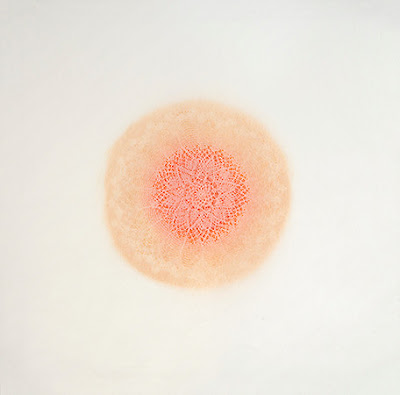AMY SANDS | A Beautiful Noise
 |
| REVOLUTION V (2015), Monotype, serigraphy. and lasercut on three layers of rice paper, 29 x 29 inches |
The art of Amy Sands presents models by which we may interpret the primordial structures and charismatic energy around us. A certain approach to artistic creation belies a felicitous understanding of what is most essential, misunderstood, or obscured in nature, and redirects it to our aesthetic comprehension. Printmaking is about process, and each of the names that are given to the types of prints carry with them the association we have to a particular process and its resulting product, which carries with it the aura of action that preceded it. Yet complexity can enter into the welter of intentions that aid in the conceptualization of these works. If the artist has ideas about her final product that carry over from other creative disciplines, such as sculpture or lace making, then the proliferation of stylistic motifs will dominate the work’s appeal, and will diverge from the assumption of traditional print making practices. This sort of dynamic is actively present in Sands’ work, and her ability to conceive it and progressively transform her medium will not only challenge the viewer but will alter how we think about art. Individually and cumulatively Sands builds an esthetic that envelops the viewer with a connection to medium and its manifestation of specific beauty.
To speak of printmaking in general is not to immediately understand how Sands interprets it. Sands does not merely construct a base image from which to create repeated impressions. She makes works that promote an ephemeral quality, with serigraphs and mono prints often combined in the same composite work. Her impetus is to create a layered effect that disingenuously plays out the ephemeral aspects on all of two or three sheets in concert with one another, leaving the viewer to question the constructs by which we judge surface detail—when in fact what she is after is a sort of visual noise.
 |
| REVOLUTION VII (2015), Monotype, serigraphy, and lasercut on three layers of rice paper, 15 x 15 inches |
The attraction to circles in Sands’ recent work possesses a range of available metaphor. Most notably, these forms were for the most part absent in early bodies of work, which attempted to achieve degrees of ephemerality within a deepening field of backgrounded hues, yet to fill in the middle and fore ground with naturally opposed tonal and graphical forms. Her newest work focuses upon the tonal qualities which illuminated past bodies of work yet were perhaps passed over by viewers in an attempt to read surface markings, dense and diverse as they were, rather than take in the work as a whole. Her new work is a Revolution in more than title. The paper, left to its raw state and dramatized by minute lighting, creates a dissolving silhouette with romantic undertones. The work is achieved in some cases by lasercutting the immensely fragile rice paper so that stacks of similar sheets press into the blank spaces, creating a crush of material, though it’s only where the lattice of each sheet interfaces with the fugitive sources of illumination that its full effect transforms the experience for the viewer. An incandescent quality animates these works, and is especially present in Revolution V, VII, and VIII, in which the use of layered sheets of rice paper creates an effect that glows upon the wall like the lost light of a distant star. The effect of combining, within the same series, works that emit an otherworldly illumination with ones that present the filigreed, seemingly dexterous details of handmade embroidery, compels the use of mere esthetic attention to come out of the shadows.
 |
| REVOLUTION VIII (2015), Monotype, serigraphy. and lasercut on three layers of rice paper, 15 x 15 inches |
Beauty is elusive despite being constructive in these works. There is a timelessness to circular forms, what in some cases takes on the fossilized appearance of a sand dollar, while in another example her use of laser cuts made through color-infused paper implies the filigreed stitching of lace curtains or stained glass windows. The use of illumination—of real time, durational light, ephemeral, that is to say transient and even fleeting as in nature, is essential to a quality aesthetic encounter with Sands’ work; though given its vulnerability, this would additionally foreshorten the life of her materials. Yet to see them only on a computer screen or in a catalogue is not to give justice to what is strongest in them. The extremely minute aspect of her materials and their reliance upon chromatically charged elements, releasing a cumulative effect through the free flow of forces such as light and wind, like blood or water, projects a quality of charismatic personification, as if nature itself were speaking with us.
Comments